+ データを開く
データを開く
- 基本情報
基本情報
| 登録情報 | データベース: PDB / ID: 5jzg | |||||||||
|---|---|---|---|---|---|---|---|---|---|---|
| タイトル | CryoEM structure of the native empty particle of a human rhinovirus C | |||||||||
 要素 要素 |
| |||||||||
 キーワード キーワード | VIRUS / jelly roll | |||||||||
| 機能・相同性 |  機能・相同性情報 機能・相同性情報symbiont-mediated suppression of host cytoplasmic pattern recognition receptor signaling pathway via inhibition of RIG-I activity / ribonucleoside triphosphate phosphatase activity / picornain 2A / symbiont-mediated suppression of host mRNA export from nucleus / symbiont genome entry into host cell via pore formation in plasma membrane / picornain 3C / T=pseudo3 icosahedral viral capsid / host cell cytoplasmic vesicle membrane / nucleoside-triphosphate phosphatase / channel activity ...symbiont-mediated suppression of host cytoplasmic pattern recognition receptor signaling pathway via inhibition of RIG-I activity / ribonucleoside triphosphate phosphatase activity / picornain 2A / symbiont-mediated suppression of host mRNA export from nucleus / symbiont genome entry into host cell via pore formation in plasma membrane / picornain 3C / T=pseudo3 icosahedral viral capsid / host cell cytoplasmic vesicle membrane / nucleoside-triphosphate phosphatase / channel activity / monoatomic ion transmembrane transport / DNA replication / RNA helicase activity / endocytosis involved in viral entry into host cell / symbiont-mediated activation of host autophagy / RNA-directed RNA polymerase / cysteine-type endopeptidase activity / viral RNA genome replication / RNA-directed RNA polymerase activity / DNA-templated transcription / virion attachment to host cell / host cell nucleus / structural molecule activity / proteolysis / RNA binding / zinc ion binding / ATP binding / membrane 類似検索 - 分子機能 | |||||||||
| 生物種 |  Rhinovirus C (ライノウイルス) Rhinovirus C (ライノウイルス) | |||||||||
| 手法 | 電子顕微鏡法 / 単粒子再構成法 / クライオ電子顕微鏡法 / 解像度: 3.16 Å | |||||||||
 データ登録者 データ登録者 | Liu, Y. / Hill, M.G. / Klose, T. / Chen, Z. / Watters, K.E. / Jiang, W. / Palmenberg, A.C. / Rossmann, M.G. | |||||||||
| 資金援助 |  米国, 2件 米国, 2件
| |||||||||
 引用 引用 |  ジャーナル: Proc Natl Acad Sci U S A / 年: 2016 ジャーナル: Proc Natl Acad Sci U S A / 年: 2016タイトル: Atomic structure of a rhinovirus C, a virus species linked to severe childhood asthma. 著者: Yue Liu / Marchel G Hill / Thomas Klose / Zhenguo Chen / Kelly Watters / Yury A Bochkov / Wen Jiang / Ann C Palmenberg / Michael G Rossmann /  要旨: Isolates of rhinovirus C (RV-C), a recently identified Enterovirus (EV) species, are the causative agents of severe respiratory infections among children and are linked to childhood asthma ...Isolates of rhinovirus C (RV-C), a recently identified Enterovirus (EV) species, are the causative agents of severe respiratory infections among children and are linked to childhood asthma exacerbations. The RV-C have been refractory to structure determination because they are difficult to propagate in vitro. Here, we report the cryo-EM atomic structures of the full virion and native empty particle (NEP) of RV-C15a. The virus has 60 "fingers" on the virus outer surface that probably function as dominant immunogens. Because the NEPs also display these fingers, they may have utility as vaccine candidates. A sequence-conserved surface depression adjacent to each finger forms a likely binding site for the sialic acid on its receptor. The RV-C, unlike other EVs, are resistant to capsid-binding antiviral compounds because the hydrophobic pocket in VP1 is filled with multiple bulky residues. These results define potential molecular determinants for designing antiviral therapeutics and vaccines. | |||||||||
| 履歴 |
|
- 構造の表示
構造の表示
| ムービー |
 ムービービューア ムービービューア |
|---|---|
| 構造ビューア | 分子:  Molmil Molmil Jmol/JSmol Jmol/JSmol |
- ダウンロードとリンク
ダウンロードとリンク
- ダウンロード
ダウンロード
| PDBx/mmCIF形式 |  5jzg.cif.gz 5jzg.cif.gz | 164.5 KB | 表示 |  PDBx/mmCIF形式 PDBx/mmCIF形式 |
|---|---|---|---|---|
| PDB形式 |  pdb5jzg.ent.gz pdb5jzg.ent.gz | 128.2 KB | 表示 |  PDB形式 PDB形式 |
| PDBx/mmJSON形式 |  5jzg.json.gz 5jzg.json.gz | ツリー表示 |  PDBx/mmJSON形式 PDBx/mmJSON形式 | |
| その他 |  その他のダウンロード その他のダウンロード |
-検証レポート
| 文書・要旨 |  5jzg_validation.pdf.gz 5jzg_validation.pdf.gz | 998.6 KB | 表示 |  wwPDB検証レポート wwPDB検証レポート |
|---|---|---|---|---|
| 文書・詳細版 |  5jzg_full_validation.pdf.gz 5jzg_full_validation.pdf.gz | 1011.7 KB | 表示 | |
| XML形式データ |  5jzg_validation.xml.gz 5jzg_validation.xml.gz | 37 KB | 表示 | |
| CIF形式データ |  5jzg_validation.cif.gz 5jzg_validation.cif.gz | 55 KB | 表示 | |
| アーカイブディレクトリ |  https://data.pdbj.org/pub/pdb/validation_reports/jz/5jzg https://data.pdbj.org/pub/pdb/validation_reports/jz/5jzg ftp://data.pdbj.org/pub/pdb/validation_reports/jz/5jzg ftp://data.pdbj.org/pub/pdb/validation_reports/jz/5jzg | HTTPS FTP |
-関連構造データ
- リンク
リンク
- 集合体
集合体
| 登録構造単位 | 
|
|---|---|
| 1 | x 60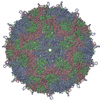
|
| 2 |
|
| 3 | x 5
|
| 4 | x 6
|
| 5 | 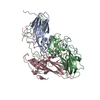
|
| 対称性 | 点対称性: (シェーンフリース記号: I (正20面体型対称)) |
- 要素
要素
| #1: タンパク質 | 分子量: 31802.623 Da / 分子数: 1 / 断片: UNP residues 568-846 / 変異: T125K / 由来タイプ: 組換発現 / 由来: (組換発現)  Rhinovirus C (ライノウイルス) / 細胞株: transduced HeLa expressing CDHR3 / 細胞株 (発現宿主): HeLa WisL / 発現宿主: Rhinovirus C (ライノウイルス) / 細胞株: transduced HeLa expressing CDHR3 / 細胞株 (発現宿主): HeLa WisL / 発現宿主:  Homo sapiens (ヒト) / 参照: UniProt: E5D8F2 Homo sapiens (ヒト) / 参照: UniProt: E5D8F2 |
|---|---|
| #2: タンパク質 | 分子量: 25965.037 Da / 分子数: 1 / 断片: UNP residues 333-567 / 由来タイプ: 組換発現 / 由来: (組換発現)  Rhinovirus C (ライノウイルス) / 細胞株: transduced HeLa expressing CDHR3 / 細胞株 (発現宿主): HeLa WisL / 発現宿主: Rhinovirus C (ライノウイルス) / 細胞株: transduced HeLa expressing CDHR3 / 細胞株 (発現宿主): HeLa WisL / 発現宿主:  Homo sapiens (ヒト) / 参照: UniProt: E5D8F2 Homo sapiens (ヒト) / 参照: UniProt: E5D8F2 |
| #3: タンパク質 | 分子量: 36247.344 Da / 分子数: 1 / 断片: UNP residues 2-332 / 由来タイプ: 組換発現 / 由来: (組換発現)  Rhinovirus C (ライノウイルス) / 細胞株: transduced HeLa expressing CDHR3 / 細胞株 (発現宿主): HeLa WisL / 発現宿主: Rhinovirus C (ライノウイルス) / 細胞株: transduced HeLa expressing CDHR3 / 細胞株 (発現宿主): HeLa WisL / 発現宿主:  Homo sapiens (ヒト) / 参照: UniProt: E5D8F2 Homo sapiens (ヒト) / 参照: UniProt: E5D8F2 |
-実験情報
-実験
| 実験 | 手法: 電子顕微鏡法 |
|---|---|
| EM実験 | 試料の集合状態: PARTICLE / 3次元再構成法: 単粒子再構成法 |
- 試料調製
試料調製
| 構成要素 | 名称: Rhinovirus C15a / タイプ: VIRUS 詳細: The cDNA of RV-C15 isolate was used to produce RNA transcripts in vitro, which were then used for transfection in HeLa WisL cells. The resultant recombinant RV-C15 virus was adapted in HeLa ...詳細: The cDNA of RV-C15 isolate was used to produce RNA transcripts in vitro, which were then used for transfection in HeLa WisL cells. The resultant recombinant RV-C15 virus was adapted in HeLa cells expressing the RV-C receptor CDHR3 via multiple passage. The derivative was the RV-C15a virus. Entity ID: all / 由来: RECOMBINANT | ||||||||||||||||||||
|---|---|---|---|---|---|---|---|---|---|---|---|---|---|---|---|---|---|---|---|---|---|
| 分子量 | 値: 5.8 MDa / 実験値: NO | ||||||||||||||||||||
| 由来(天然) | 生物種:  Rhinovirus C15a (ライノウイルス) Rhinovirus C15a (ライノウイルス) | ||||||||||||||||||||
| 由来(組換発現) | 生物種:  Homo sapiens (ヒト) / 細胞: HeLa / プラスミド: pC15 Homo sapiens (ヒト) / 細胞: HeLa / プラスミド: pC15 | ||||||||||||||||||||
| ウイルスについての詳細 | 中空か: YES / エンベロープを持つか: NO / 単離: STRAIN / タイプ: VIRUS-LIKE PARTICLE | ||||||||||||||||||||
| 天然宿主 | 生物種: Homo sapiens | ||||||||||||||||||||
| ウイルス殻 | 名称: Capsid (p3) / 直径: 300 nm / 三角数 (T数): 3 | ||||||||||||||||||||
| 緩衝液 | pH: 8 | ||||||||||||||||||||
| 緩衝液成分 |
| ||||||||||||||||||||
| 試料 | 濃度: 1 mg/ml / 包埋: NO / シャドウイング: NO / 染色: NO / 凍結: YES | ||||||||||||||||||||
| 試料支持 | グリッドの材料: COPPER / グリッドのサイズ: 400 divisions/in. / グリッドのタイプ: Ultra thin Lacey carbon | ||||||||||||||||||||
| 急速凍結 | 装置: GATAN CRYOPLUNGE 3 / 凍結剤: ETHANE / 湿度: 80 % / 凍結前の試料温度: 298 K |
- 電子顕微鏡撮影
電子顕微鏡撮影
| 実験機器 |  モデル: Titan Krios / 画像提供: FEI Company |
|---|---|
| 顕微鏡 | モデル: FEI TITAN KRIOS |
| 電子銃 | 電子線源:  FIELD EMISSION GUN / 加速電圧: 300 kV / 照射モード: FLOOD BEAM FIELD EMISSION GUN / 加速電圧: 300 kV / 照射モード: FLOOD BEAM |
| 電子レンズ | モード: BRIGHT FIELD / 倍率(公称値): 14000 X / Calibrated defocus min: 700 nm / 最大 デフォーカス(補正後): 3500 nm / Cs: 2.7 mm / C2レンズ絞り径: 100 µm / アライメント法: COMA FREE |
| 試料ホルダ | 凍結剤: NITROGEN 試料ホルダーモデル: FEI TITAN KRIOS AUTOGRID HOLDER |
| 撮影 | 平均露光時間: 14 sec. / 電子線照射量: 25.7 e/Å2 / 検出モード: SUPER-RESOLUTION フィルム・検出器のモデル: GATAN K2 SUMMIT (4k x 4k) 撮影したグリッド数: 3 / 実像数: 3614 |
| 画像スキャン | 動画フレーム数/画像: 70 / 利用したフレーム数/画像: 3-70 |
- 解析
解析
| EMソフトウェア |
| ||||||||||||||||||||||||||||||||||||||||||||||||||||||||||||
|---|---|---|---|---|---|---|---|---|---|---|---|---|---|---|---|---|---|---|---|---|---|---|---|---|---|---|---|---|---|---|---|---|---|---|---|---|---|---|---|---|---|---|---|---|---|---|---|---|---|---|---|---|---|---|---|---|---|---|---|---|---|
| CTF補正 | 詳細: CTF correction was performed on the fly during 2D alignment and 3D reconstruction. タイプ: PHASE FLIPPING ONLY | ||||||||||||||||||||||||||||||||||||||||||||||||||||||||||||
| 粒子像の選択 | 選択した粒子像数: 24882 詳細: A mixed population of empty particles, full particles, and junk | ||||||||||||||||||||||||||||||||||||||||||||||||||||||||||||
| 対称性 | 点対称性: I (正20面体型対称) | ||||||||||||||||||||||||||||||||||||||||||||||||||||||||||||
| 3次元再構成 | 解像度: 3.16 Å / 解像度の算出法: FSC 0.143 CUT-OFF / 粒子像の数: 3614 / 対称性のタイプ: POINT | ||||||||||||||||||||||||||||||||||||||||||||||||||||||||||||
| 原子モデル構築 | プロトコル: RIGID BODY FIT / 空間: REAL / Target criteria: Correlation coefficient |
 ムービー
ムービー コントローラー
コントローラー






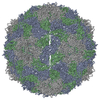
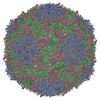
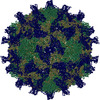
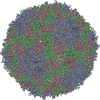
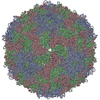
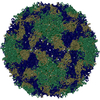
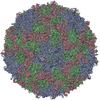

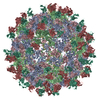
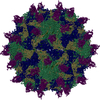
 PDBj
PDBj

